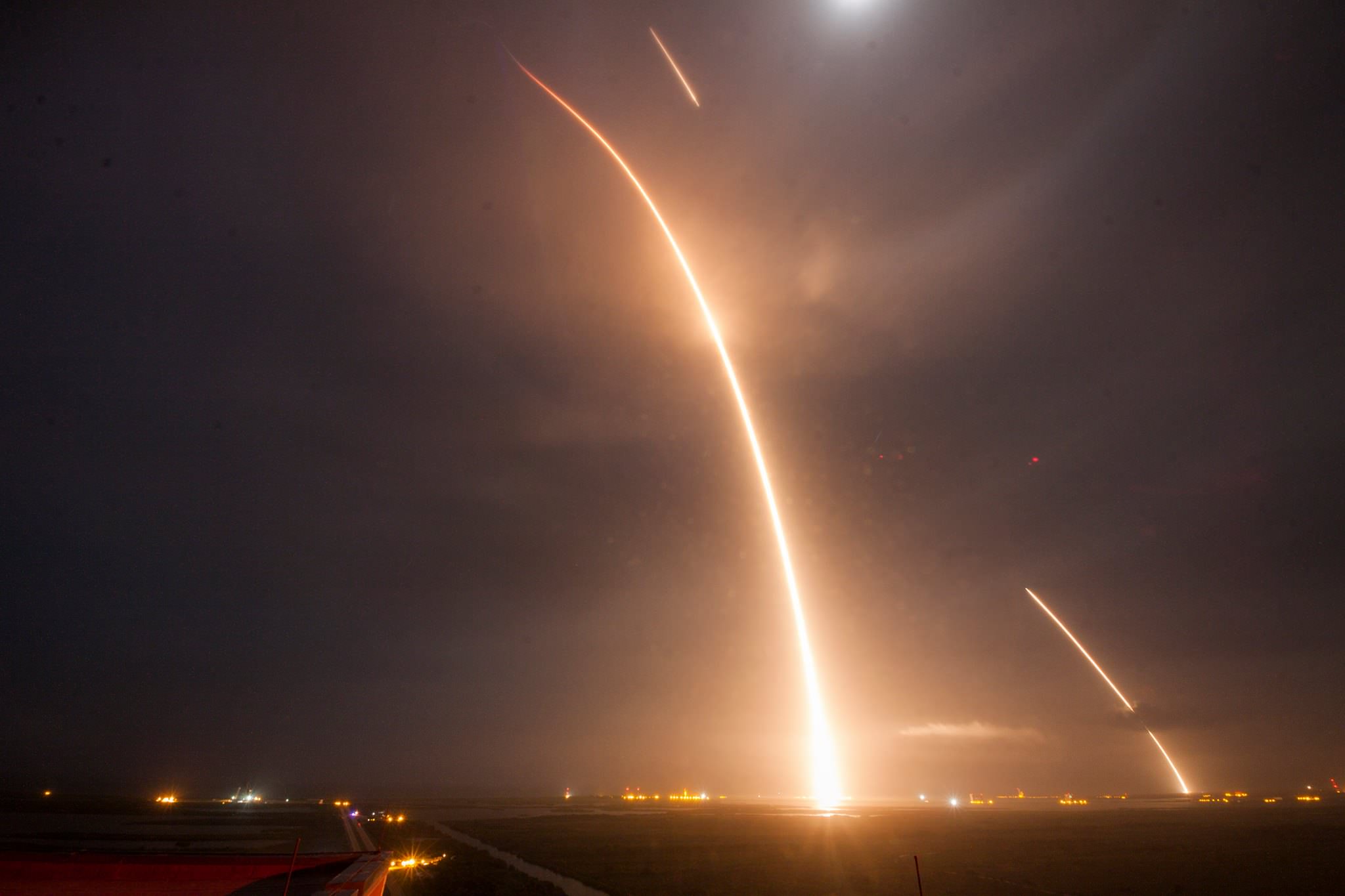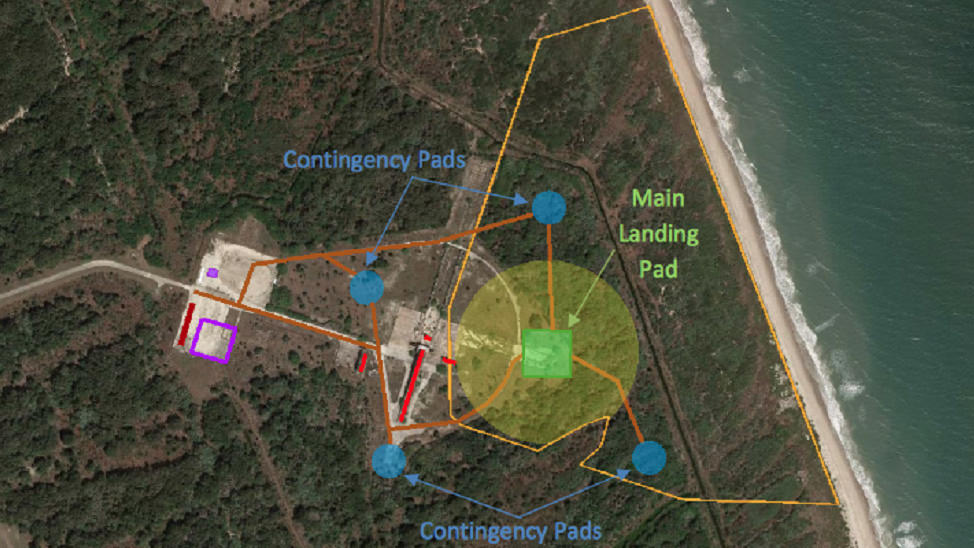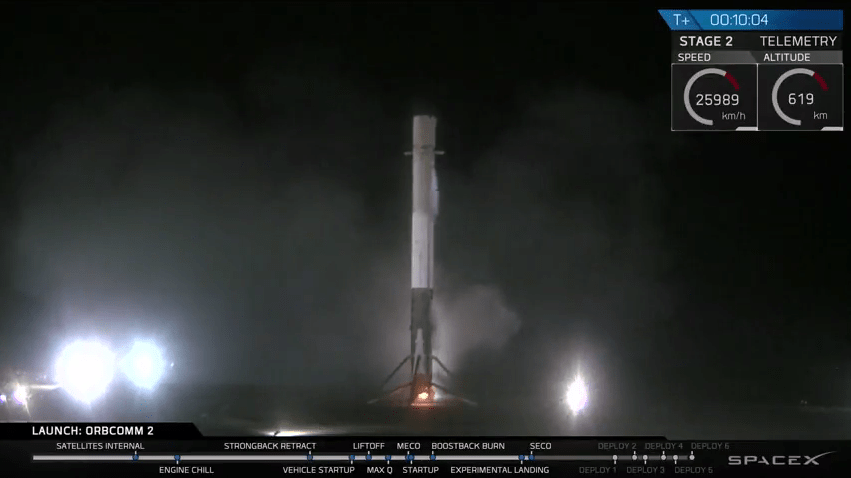“The Falcon Has Landed!” gushed exuberant SpaceX officials following tonight’s (Dec 21) history making upright ground landing of the firms spent Falcon 9 boost stage barely 10 minutes after if launched on a critical mission to deliver a constellation of commercial communications satellites to Earth orbit.
Breaking News: Check Back later for more. See more photos video in follow up story here
Following a spectacular nighttime blastoff from Cape Canaveral, Fla, SpaceX has just successfully recovered and soft landed the 156 foot tall first stage of their Falcon 9 rocket back on the ground at the Cape – in a monumental and historic space feat that will reverberate around the world. This is a game changing moment that will alter the future of space travel.
WATCH the SpaceX webcast as the first stage lands, at about 31 minutes in the video:
Local area spectators cheered the launch and clearly saw the landing. They said several powerful sonic booms could be heard thundering loudly across the space coast. It was one of the most amazing sights they had ever seen, many folks said.
The upgraded SpaceX Falcon 9 launched a fleet 11 ORBCOMM OG2 communications satellites to orbit on Monday, Dec. 21 at 8:29 p.m. from Space Launch Complex 40 on Cape Canaveral Air Force Station, Fla.
The stunning liftoff and landing marked the Falcon 9 boosters ‘Return to Flight’ and is the first launch for SpaceX since the catastrophic mid-air destruction of the rocket six months ago on June 28, 2015 – after launching from the same pad as today – on a cargo mission for NASA bound for the International Space Station (ISS) and her six person crew.
The first stage landing, vertically at night, was apparently perfect and came off without a hitch by all accounts.
The Falcon 9 is equipped with four landing legs and four grid fins to enable the propulsive landing back on the ground at the Cape, once the first stage separates and relights a Merlin 1D engine.
About 3 minutes after liftoff and about 60 miles altitude, the spent first stage separated from the second stage which continued to orbit with the Orbcomm satellites.
While moving at extremely high speed of some 3000 mph, the rocket was then commanded to fire cold gas nitrogen attitude thrusters to reorient itself and to turn the vehicle around – its sort of like riding on a broomstick in a hurricane. It then conducted a boostback burn with a first stage Merlin 1D engine to create a reversed ballistic arc. Then it conducted a reentry burn and finally a landing burn above the ground at Landing Zone 1 at Cape Canaveral.
The quartet of side mounted landing legs were lowered into place in the final moments before touchdown.

The history making landing attempt of the boosters first stage took place back at the Cape at the SpaceX Landing Zone 1 site at about 8:39 p.m. EST after high altitude separation from the upper stage and around 10 minutes after launch.
The entire event from launch to landing was shown via a live SpaceX webcast.
The goal is to recover and eventually reuse the boosters in order to radically cut the cost of sending payloads and people to space, as often stated by SpaceX CEO Elon Musk.
But the key step to solve is you first have to recover the booster before you can even think about relaunching it. After its recovered it can then be thoroughly analyzed for the impact of aerodynamic stresses and the engine firings to determine the feasibility of refurbishment and reusability for relaunch.

Landing the Falcon 9 rockets first stage on land at SpaceX’s Landing Zone 1 (LZ-1) complex by a pinpoint propulsive soft landing was the secondary test objective. Landing Zone 1 is located some six miles south of launch pad 40 at Cape Canaveral.
Because of the proximity to populated areas, SpaceX required special approvals for the surface landing test from the Air Force and the FAA. And much of the military base and NASA installations have been evacuated for safety reasons. Media are also not allowed to watch and photograph from their customary locations on site at Cape Canaveral Air Force Station.
SpaceX has built Landing Zone 1 by renovating and refurbishing an abandoned area previously known as Space Launch Complex 13 (SLC-13).
Landing Zone 1 measures about 282 feet in diameter and is constructed of reinforced concrete. SpaceX has actually built several of the concrete landing pads for use as a landing site by the firms Falcon 9 as well as the triple barreled Falcon Heavy boosters which may debut in 2016.
Launch Complex 13 is a former U.S. Air Force rocket and missile testing range last used in 1978 for test launches of the Atlas ICBM and subsequently for operational Atlas launches.

The primary mission was to carry a payload of eleven small commercial communications satellites for Orbcomm on the second OG2 mission. They were fueled and stacked on the satellite dispenser and encapsulated inside the payload fairing.
All 11 of the refrigerator sized OG2 satellites were successfully deployed as planned at an altitude of about 400 mi (620 km). They joined the existing fleet of OG2 satellites.
The 380 pound (170 kg) satellites were deployed two at a time from the satellite dispenser during six separation events. The staggered deployment of the 170 kg comsats took place over about four minutes from 8:42 p.m. to 8 46 p.m. in order to place the constellation of spacecraft into the proper orbit.

This was the second and last OG2 launch for OrbComm. SpaceX has already notched one successful launch for Orbcomm when the first six Orbcomm OG2 satellites lifted off on July 14, 2014.
The ORBCOMM OG2 satellites provide Machine – to – Machine (M2M) messaging and Automatic Identification System (AIS) services.
Overall it was a wildly successful ‘Return to Flight’ and a historic day for SpaceX.

Stay tuned here for Ken’s continuing Earth and planetary science and human spaceflight news.



Yes, pretty good but I think they are going to need some touch up paint on those fins. I’d work on that if I were you ELON MUSK, Master of the UNIVERSE!
Some people I never understand. Your comment stinks!
Is it possible the struts are considered expendable and were never intended to be flown more than once – are easily replaced? Hmm… they ARE exposed to some pretty high temperatures. I wonder how high?
Wow!!!!!!!! Congratulations SpaceX! I am looking forward to seeing more 1st stage propulsive landings – something that never seems to get old.
This was just AWESOME! The fact that they did a return to flight using their OWN rocket after just six months was amazing by itself, but landing the 1st stage is a total game changer. Congrats to everyone at SpaceX! To paraphrase America’s favorite demagogue, this was HUGE!
Brilliant! What was best was watching the broadcast with all the SpaceX people going ape crazy and the second stage commentator struggling to contain his emotions.
I watched from 8min to launch and I didn’t expect to stand up and applaud and the succesful landing.
Elon Musk stated that this first stage won’t fly again. This is still a step into the right direction. I assume that this refers to a succesfull sea landing and re-usability testing. And maybe? a succesfull return of the 2nd stage as well.
At least this Falcon will be tested at full throttle before becoming SpaceX’s permanent statement of its vision.
I suppose they have to inspect carefully the rocket so they’ll know if they can re-use future re-entred and landed rockets or all this effor has been in vane.
For the past near 60 years I have been a fan of all the aspects rocketry and spaceflight. Thanks, Elon, for being such an inspiration! WE WANT MORE 😉
Amazing success. I watched the live stream but after all happened and I was hyped. This is fantastic and extremely inspirational to see everyone cheering
The X marks the spot… And hell it did.
This is one of the Greatest achievements of mankind so far. Well done SpaceX you have made History and all the World was watching Fantastic! From your friends in Europe….
YES! Go SpaceX!
As mentioned above, this rocket won’t fly again? THAT makes perfect sense… wouldn’t YOU want to x-ray, sonogram, megnetogram etc. to know exactly how well all the materials and structures performed? ESPECIALLY those pesky oxidizer tank struts!
Aqua, As Elon stated they will never fly this first stage- it will be subject of intense analysis to see how much reusability they can get with the current setup… As you probably realize, they wont be having the oppotunity to look at those oxidizer tank struts as they are in the 2nd stage which would have burned up on re-entry after delivering the payloads.. Musk has stated the steel struts will be replaced with inconel which being a nickel alloy has a lower expansion coefficient (cte) and is stronger (and more expensive) with more sheer strength.. (since there are I think 4 or 6 single struts supporting each the of 2nd stage lox tanks, they need to hold them so they dont drop onto the rocket engine and go boom)..
So the first stage booster doesn’t use oxidizer tank struts? My comment was prior to Elan’s announcement.
This is a pretty awesome success! However, this is just the first step toward reusability and lowering of the launch costs. There are going to be depreciation, inspection and refurbishment costs and the first stage constitutes only about 75% of the overall cost of F9 rocket. My guess would be that in a few years the costs will come down about 30-50% (for reused stage, some will probably always opt for new stage). For F9 Heavy the three first stage cores together constitute close to 90%, so the saving can be correspondingly higher.